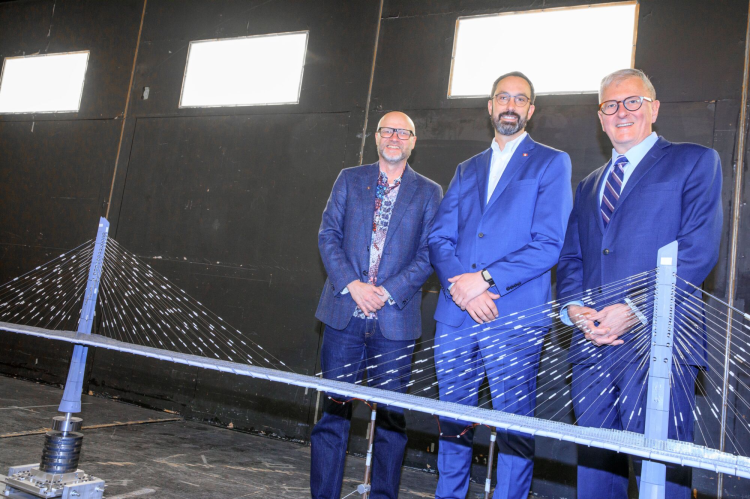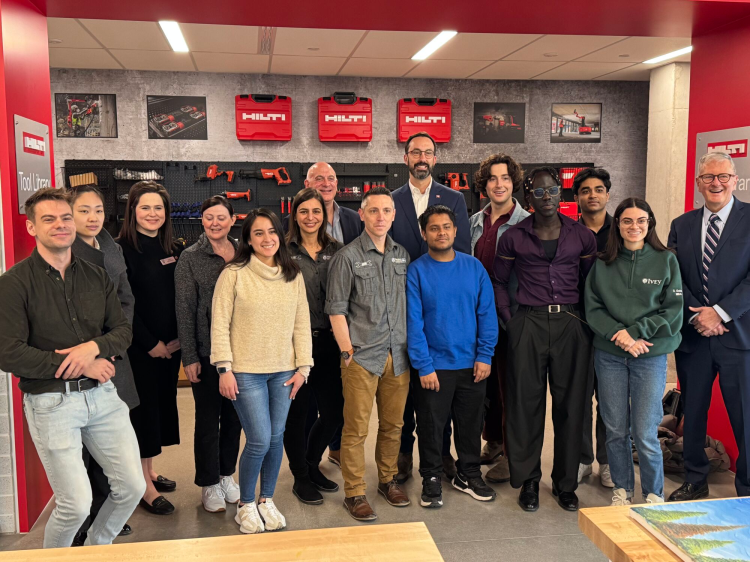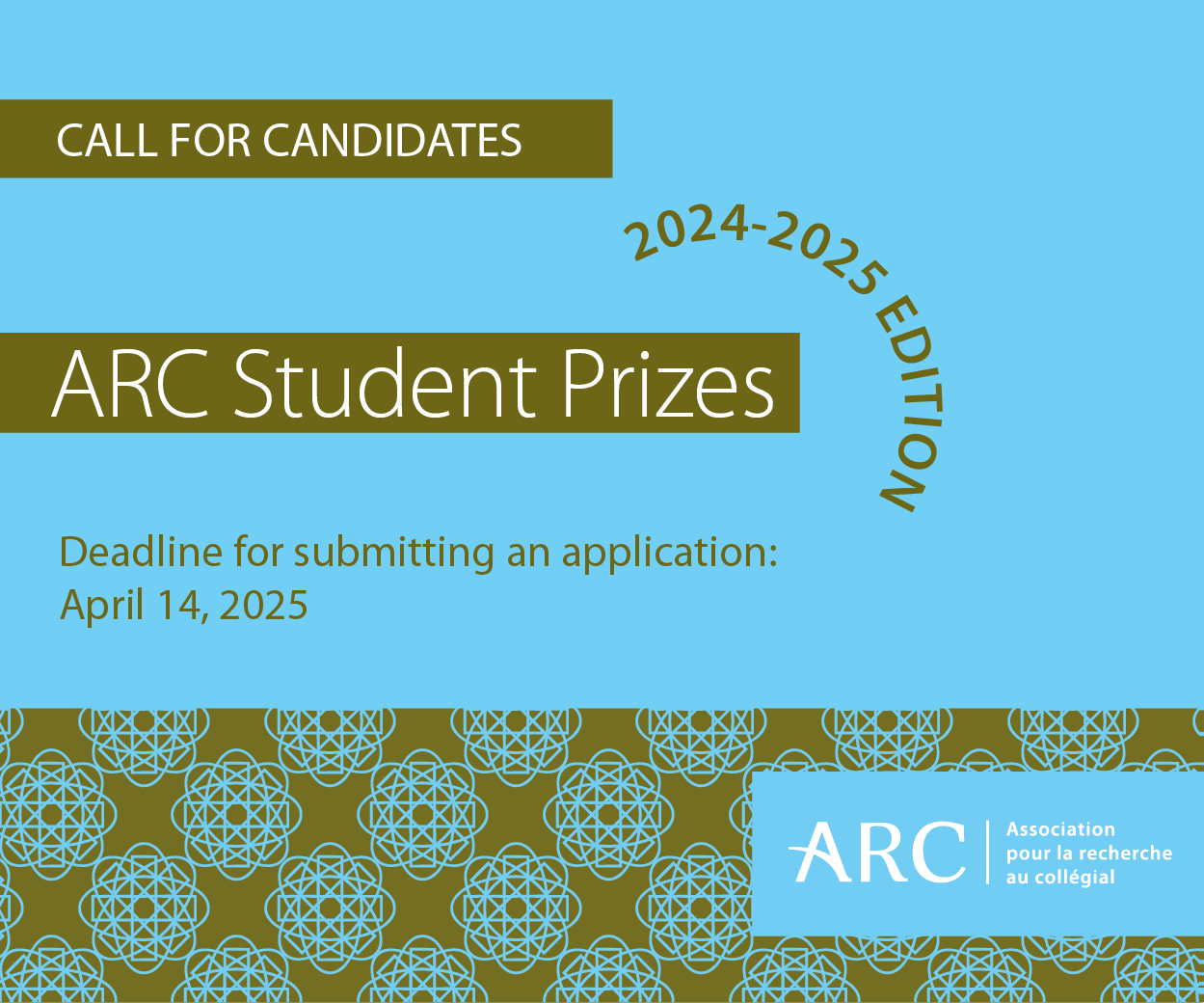Western students helped welcome Minister of Colleges, Universities, Research Excellence and Security, Nolan Quinn, to campus earlier this week, where they're learning skills to prepare them to lead and innovate in critical sectors.
Quinn also met researchers and educators training the next generation while touring Surface Science Western and the Boundary Layer Wind Tunnel in the Faculty of Engineering.
"STEM programs across Ontario are preparing students for in-demand jobs that drive Ontario's economy," said Quinn. "It was a pleasure to visit Western to tour their cutting-edge facilities and meet the incredible students who are learning the skills they need to thrive in our critical sectors."
Surface Science Western: Hands-on training for students at all levels of study
Quinn's first stop was a visit to Surface Science Western (SSW), a self-sustaining business unit and leading consulting and research laboratory, specializing in materials science, chemistry, engineering, polymers, geology, physics and metallurgy.
Joining the tour was Paul Ragogna, associate dean (research), chemistry professor in the Faculty of Science, and an affiliate member of SSW.
Ragogna said the facility, which offers students access to 14 skilled research scientists with expertise in industrial and academic projects, provides the advanced technical and hands-on training required to secure jobs across many sectors, from automotive and EVs, to mineralogy and nuclear materials.
"There's a lot of life after your degree, so it's important to train people who can go out into the world, do work and be ready for it," Ragogna said.
Vahid Dehnavi, senior research scientist and materials and metallurgical engineer, agrees.
"In many other labs, a technician runs the samples, but here, we train the students and postdocs to use the instruments themselves," Dehnavi said.
"Many of our graduates end up working in industries, including Canadian Nuclear Laboratories and nuclear waste management organizations."
Postdoctoral associate René Pütz said he finds the hands-on experience with advanced instrumentation "invaluable."
"This combination of practical training and exposure to knowledge of the highest international standards presents a unique opportunity to refine advanced skills in surface science and address complex research challenges," Pütz said.
As students at all levels learn alongside top research scientists, analyzing materials to support academic research and industrial clients, they become part of SSW's team of problem-solvers.
"There are a lot of common failures in many industries including food, nuclear and automotive," Dehnavi said. "Using our expertise, instruments and equipment, we help them find solutions."
For example, research scientist and SSW quality manager Becky Sarazen can help automotive paint shops address paint defects. Her team and trainees analyze paint layers to track down the point in the production process the defect started.
"We can lead them to the source of the problem and help them get back up and running," Sarazen said.
Wind engineering at Western: Training the next generation of wind and climate engineers
At the Boundary Layer Wind Tunnel Laboratory, Western engineering professor and ImpactWX Chair in Severe Storms Engineering Greg Kopp walked Quinn through what is considered the birthplace of the modern practice of wind engineering. Here, the tallest and longest structures in the world have been tested, including the CN Tower, the Willis Tower and The Confederation Bridge.
Home of Canada's only graduate program in wind engineering and the Northern Tornadoes Project, Western's wind engineering graduates find employment in diverse sectors, including wind and solar energy, electric transmission/distribution, insurance, automotive and aerospace.

As part of a campus tour March 25, Minister of Colleges, Universities, Research Excellence and Security, Nolan Quinn, visited the Boundary Layer Wind Tunnel in the Faculty of Engineering. (L to R): Western engineering professor and ImpactWX Chair in Severe Storms Engineering Greg Kopp, Minister Quinn and Western President Alan Shepard. (Christopher Kindratsky/Western Communications)
Home of largest maker space in Canada, open to students in all faculties
The minister's campus tour concluded with a visit to the Hilti Tool Library at the Schmeichel Building for Innovation and Entrepreneurship, where students across campus can access state-of-the-art tools in the Sabourin Family Foundation Maker Space one of two maker spaces within the facility.
Home to the Morrissette Institute for Entrepreneurship, Western equips students with the skills and mindset to turn ideas into action and challenges into opportunities.
Neil Enns, a Morrissette Entrepreneurship staff member known as the "master maker," has been guiding students through the fundamentals of design and working with tools over the last few months.
"What I love about it is that we can empower students through the ability to use tools. That translates into them having a broader horizon for their vision," Enns said.
"Their dreams can be bigger."

As part of a campus tour March 25, Minister of Colleges, Universities, Research Excellence and Security, Nolan Quinn, visited the Hilti Tool Library, at the Schmeichel Building for Innovation and Entrepreneurship. (Submitted)













